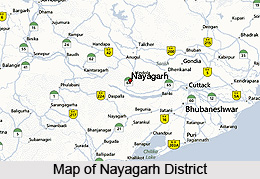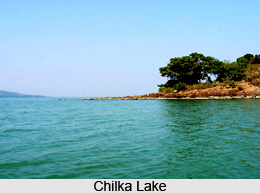 Nayagarh District is located towards the west of Puri District surrounded by Cuttack District in the north, Phulbani District in the west, Ganjam district in the south and Khurda district in the east. The District of Nayagarh lies between 19 degree 54 minutes to 20 degree 32 minutes north latitude and 84 degree 29 minutes to 85 degree 27 minutes east longitude. Nayagarh District is situated in the hilly ranges in the west and its north eastern parts has formed a small well cultivated fertile valleys intersected by small streams. This district is in the higher altitude than the sea level and above flood level. Mahanadi River flows in the eastern boundary of the district.
Nayagarh District is located towards the west of Puri District surrounded by Cuttack District in the north, Phulbani District in the west, Ganjam district in the south and Khurda district in the east. The District of Nayagarh lies between 19 degree 54 minutes to 20 degree 32 minutes north latitude and 84 degree 29 minutes to 85 degree 27 minutes east longitude. Nayagarh District is situated in the hilly ranges in the west and its north eastern parts has formed a small well cultivated fertile valleys intersected by small streams. This district is in the higher altitude than the sea level and above flood level. Mahanadi River flows in the eastern boundary of the district.
History of Nayagarh District
Birth history of Nayagarh District in around the thirteenth century and is considered as an important part in the political history of Orissa. King Suryamani of Baghela dynasty came to Puri on a pilgrimage from Madhya Pradesh and established his kingdom at Nayagarh. Nayagarh District consists of the four Garjat states of ex-states Ranpur, Nayagarh, Khandapara and Daspalla. The aboriginal `Savaras` and Kandhas are the indigenous people of Nayagarh District. The Aryans came later. Besides, there are people of Semitic and Islamic faiths. Nayagarh District with its ex-states of Nayagarh, Khandapara, Daspalla and Ranpur played a major role in the freedom struggle of India.
Geography of Nayagarh District
Geography of Nayagarh District comprises a hilly patch of land. There are several rivers that flow through the district. Mahanadi River enters this district at Kuturi under Gania Block and takes an easterly course along Gania, Khandapara and Bhapur Blocks for about 55 kms. The river here discharges a large volume of water in narrow channel flanked by high precipitous hills. River Brutanga, a tributary of river Mahanadi, rises from the hilly areas of Phulbani and Bhanjanagar and carries large volumes of water to river Mahanadi. Kusumi River rises from Panchabati in Bhanjanagar Sub-Division of Ganjam District.
 River Malaguni emanates from the hills of Ranpur Tehsil and takes its winding course and merges in Chilka Lake. Other rivers flowing through in Nayagarh District include Budhabudhiani, Kuanria and Dahuka rivers where medium Irrigation projects have been constructed. The climate of Nayagarh District is of extreme type and it is very hot in the summer season.
River Malaguni emanates from the hills of Ranpur Tehsil and takes its winding course and merges in Chilka Lake. Other rivers flowing through in Nayagarh District include Budhabudhiani, Kuanria and Dahuka rivers where medium Irrigation projects have been constructed. The climate of Nayagarh District is of extreme type and it is very hot in the summer season.
Culture of Nayagarh District
Culture of Nayagarh District is a composite culture of heterogeneous faiths. Culture of Nayagarh District includes several indigenous festivals like Ravanapodi at Daspalla, Pana Sanakranti of Dakhinakali, Shivaratri at Sarankul, Magha Saptami (Kantilo Mela) at Kantilo, Ramnavami at Odagaon and Car Festival at Nayagarh, Khandapara, Dasapalla and Ranapur. Kalesi dance, Dinda Dhangedi dance, Matia dance, Paika dance, Dhuduki nacha, Duari dance and Danda nacha are some of the popular folk dances of Nayagarh District.
Tourism in Nayagarh District
Tourism in Nayagarh District comprises visits to several well known sites having historical and religious significance. Sarankul, Odagaon, Dutikeswar, Kantilo, Daspalla, Ranapur, Asurkumari, Barmul, Satokasia Gorge Sanctuary, Sitalpani, Baisipalli sanctuary, Tarabalo and Udayapur Library are some of the popular places to be explored in Nayagarh District. Diverse species of fauna can also be seen here. People from far and wide come and explore the various tourist places of this district. Further, there are several Shaiva Shrines in the district. Prominent among the Shaiva Shrines in Nayagarh District are the twelve Swayambua Siva; Ugrasvara at Badapandusar, Dhabaleswar at Lachhipur, Phulesvara at Bahadajholla, Singhesvara at Jadupur, Madhukesvara at Rabera, Somanath Dev at Gondapur, Maktesvara at Gotisahi, Dutikesvara at Jamupatna, Gatisvara at Malisahi, Ardha Sambhu at Panchagada Dibyasinghpur. Besides, there are so many other Shaiva temples scattered all over the district.
Nayagarh District is famous for its brass works.






